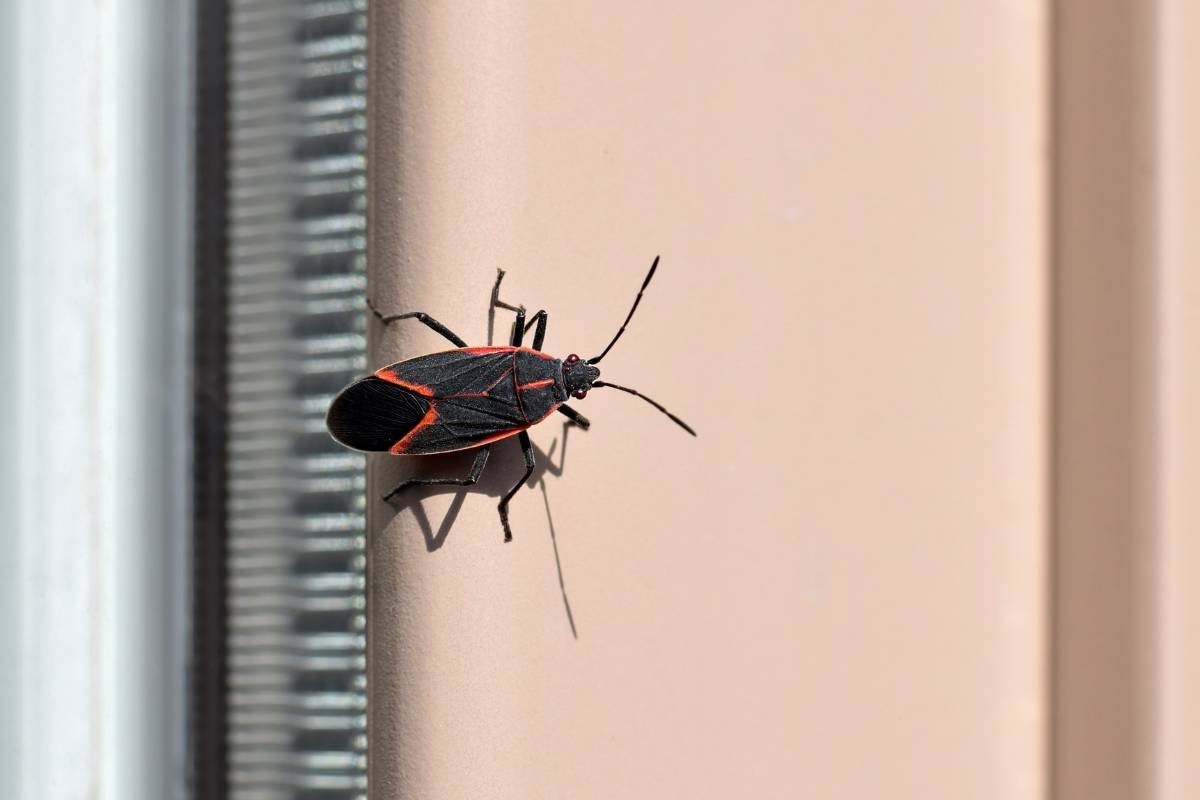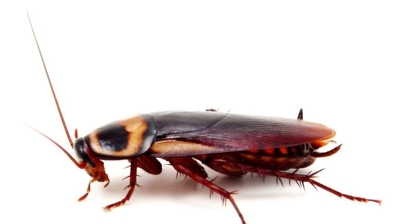
Boxelder Bug Control Services

Boxelder Bugs
Boxelder bugs are not harmful in a traditional sense—they don’t bite, sting, transmit disease, or damage structures. However, they become a significant nuisance when they invade buildings en masse, stain surfaces, and create an unpleasant living environment. Here's a breakdown of their potential impact:
- Indoor Nuisance: They are problematic primarily because they invade buildings in large numbers to overwinter. Once inside, they may stain walls, curtains, upholstery, and clothing with their excrement, which leaves behind reddish-brown spots. When crushed, they emit a foul odor from their defensive scent glands. They can reappear indoors during warm winter days or early spring, creating a repeated annoyance.
- Biting or Stinging: Boxelder bugs do not bite or sting. They have piercing-sucking mouthparts used to feed on plant material, not to bite humans or animals.
- Toxicity: They are not venomous or toxic to humans or pets. However, if pets (particularly dogs or cats) eat them in large numbers, it may cause mild gastrointestinal upset due to the bugs’ bitter-tasting defensive compounds.
- Allergic Reactions: Very rarely, some sensitive individuals might experience mild skin irritation upon contact, but this is uncommon and not serious.
- No Structural Damage: Boxelder bugs do not chew wood, wiring, insulation, or building materials, so they do not cause structural damage to homes or buildings.
Boxelder bugs are classified as nuisance pests—meaning they’re more of a comfort and cleanliness issue than a threat. Despite not being dangerous, they can generate considerable frustration for homeowners because they cluster visibly in large numbers on sunny exterior walls in the fall. Their presence indoors is unsettling, especially in winter when homeowners don't expect insect activity. DIY control is often ineffective without professional exclusion and perimeter treatments.
Learn more: Do Boxelder Bugs Bite? || What Do Boxelder Bugs Eat?
Boxelder Bug Removal
Boxelder bugs may look harmless, but letting them stick around can create a range of problems that become more serious the longer they’re ignored. While these bugs don’t bite, sting, or cause structural damage, they invade in large numbers, and that sheer volume is what makes them a real nuisance. As temperatures cool, they congregate on sun-facing walls and squeeze into gaps around siding, windows, vents, and rooflines. Once they slip inside, they often end up in living spaces, where they stain surfaces with their excrement and give off an unpleasant odor when crushed or disturbed. Outdoors, heavy populations can damage young trees by feeding on seeds and tender plant tissue, stressing ornamental maples, fruit trees, and—of course—boxelders. Their presence also attracts secondary pests such as spiders that feed on them, creating additional pest pressure around the property. Addressing an infestation early prevents overwintering inside the home, reduces seasonal population spikes, protects landscaping, and avoids the constant cleanup and frustration that come with large swarms. For homeowners, it’s ultimately a matter of comfort, sanitation, and preventing an annoyance from turning into a recurring, yearly invasion.
Learn more: How To Get Rid Of Boxelder Bugs
Boxelder Bug Control
Hiring our professional boxelder bug control services is the most effective and reliable way to handle an infestation because these pests are persistent, seasonal, and often overwhelming in large numbers. While they don’t typically cause structural damage, they invade homes and businesses in massive swarms, stain walls and furniture with their excrement, and emit an unpleasant odor when crushed. Attempting to control them on your own often leads to frustration, as DIY sprays and vacuums only provide temporary relief without addressing the root cause of the infestation.
Our professionals use targeted, proven treatments to eliminate existing boxelder bugs and create a protective barrier around your property to prevent future invasions. We have access to commercial-grade products and application methods not available to the public, ensuring longer-lasting and safer results. In addition, our experts can identify and seal entry points, recommend habitat modifications, and provide a tailored plan that keeps boxelder bugs from returning each season.
Ultimately, hiring our professional pest control saves time, prevents recurring infestations, protects your property, and gives you peace of mind knowing the problem is handled effectively.
Boxelder Bug Exterminators
Choosing our local exterminators over a national chain can make a clear difference when dealing with boxelder bugs, largely because these bugs are highly seasonal and behave differently depending on the region. Our local professionals are tuned in to the exact conditions that drive outbreaks in the area—specific tree varieties, neighborhood microclimates, common entry points in local construction styles, and the timing of seasonal migrations. This local knowledge leads to faster identification of the root cause and a more precise treatment strategy.
You also gain a level of responsiveness that big companies have a hard time matching. Our local team typically provides quicker scheduling, direct communication with the technician who will actually do the work, and consistent follow-through from the same person rather than rotating crews. That continuity matters when you’re dealing with pests like boxelder bugs that return year after year if preventive work isn’t done correctly.
There’s also a practical difference in the thoroughness of service. Our local exterminators rely heavily on our reputation and word of mouth, so we spend more time sealing entry points, treating exterior surfaces at the right seasonal windows, and giving tailored advice to reduce future pressure—steps that get rushed or standardized in large corporate models.
Our local exterminators bring sharper regional expertise, better communication, greater accountability, and more personalized prevention—qualities that make boxelder bug control more effective and less frustrating for homeowners.
What Do Boxelder Bugs Look Like?
Boxelder bugs are distinctive in appearance and fairly easy to identify, especially once you know what to look for:
Adult Boxelder Bugs
- Size: Approximately ½ inch (12–14 mm) long.
- Shape: Elongated, oval-shaped body with a somewhat flattened appearance.
- Color: Matte black or dark brown.
- Markings: Prominent reddish-orange or bright red lines outlining the thorax and running along the edges of the wings. When at rest, their folded wings form an “X” pattern on their back, highlighted by the red markings.
- Wings: Adults are fully winged and capable of flying, though they are slow and not particularly agile in flight.
- Antennae: Long, thin, and black, typically held out in front when moving.
Nymphs (Immature Boxelder Bugs)
- Size: Much smaller than adults, growing gradually through several stages (instars).
- Color: Bright red or crimson body in early stages. As they mature, their black legs and wing pads begin to develop.
- Shape: Oval and wingless in early stages; wings begin to appear and darken with each molt.
Behavioral Traits That Help Identify Them
- Tend to cluster in large groups on warm, sunlit surfaces—especially on the south and west sides of buildings, trees, and rocks.
- Commonly seen in late summer and fall as they prepare to overwinter.
- Inside homes, they often appear around windows, door frames, or warm indoor surfaces.
Where Are Boxelder Bugs Found?
Boxelder bugs are found throughout North America, particularly in areas where their preferred host trees—boxelder trees, along with maples and ash trees—are common. Their range, however, and their behavior can vary slightly based on climate, urban development, and seasonal patterns.
Geographic Distribution
- United States: Boxelder bugs are widespread across the eastern, central, and western U.S., with particularly heavy populations in the Midwest (Minnesota, Iowa, Illinois, Wisconsin), the Great Plains, parts of the Northeast, the Pacific Northwest, and some parts of the Southwest, especially where irrigation supports the growth of boxelder and maple trees.
- Canada: Common in southern Canada, especially in Ontario, Manitoba, and parts of British Columbia.
- Other Areas: While not native to all regions, they have been introduced in some non-native areas where boxelder trees have been planted ornamentally.
Outdoors (During Spring to Early Fall)
- Host Trees: Boxelder trees (Acer negundo) are their primary breeding and feeding site. They also feed on silver maples, sugar maples, and ash trees.
- Leaf Litter & Ground Cover: Nymphs and adults may be seen in mulched beds, garden debris, or beneath trees where fallen seeds accumulate.
- Sunny Surfaces: In late summer and fall, adults cluster on sun-warmed exterior surfaces, especially south- and west-facing walls, siding, rocks, tree trunks, patios, and decks.
Indoors (Fall through Early Spring)
- Boxelder bugs become a nuisance indoors as temperatures drop in autumn. They seek protected, warm places to overwinter.
- Entry Points may be gaps in siding, around windows, doors, and vents, or attics, crawl spaces, wall voids, and basements. Once inside, they may remain hidden for weeks or months, occasionally emerging on sunny winter days.
Preferred Conditions
- Warmth: Boxelder bugs are drawn to sun-exposed surfaces. This thermophilic behavior is why they often gather on the sunny side of buildings.
- Dry Environments: They prefer dry conditions for overwintering, avoiding damp or humid areas.
- Light-Colored Structures: Light-colored homes and buildings often attract more boxelder bugs because they retain heat from sunlight.
Boxelder Bug Life Cycle
The life cycle of boxelder bugs (Boisea trivittata) is relatively simple and follows incomplete metamorphosis, consisting of three main stages: egg, nymph, and adult. Here is an overview of the life cycle of boxelder bugs:
- Boxelder Bug Eggs: The boxelder bug life cycle typically begins in late spring or early summer when adult females lay clusters of small, reddish-brown eggs. These eggs are usually laid on the bark, leaves, or in crevices of their host trees, which are primarily boxelder (Acer negundo) trees but can also include other maple and ash species. Each egg cluster can contain anywhere from a dozen to several dozen eggs. The eggs typically take about one to two weeks to hatch, depending on temperature and environmental conditions.
- Boxelder Bug Nymphs: When the eggs hatch, nymphs emerge. Nymphs are the immature stages of boxelder bugs and undergo several molts as they grow and develop. Nymphs initially appear bright red-orange and are wingless. As they mature through five instar stages, they gradually darken in color and develop wing pads. Nymphs are relatively small and resemble smaller versions of the adult boxelder bugs. The nymphal stage lasts for several weeks, during which time they feed on the sap and seeds of host trees.

Hear From Our Happy Customers
-
"Wonderful Service"
Wonderful service. Jarvis is great. Took care of everything I needed. Thank you!
- Henry P. -
"Fantastic & Patient"
Jarvis was fantastic and patient. He answered my questions with an in-depth explanation and addressed all of my areas of concern. Would love for him to be my assigned tech going forward. Well done!
- Yonnette M. -
"Professional & Considerate"
I’m pleased with Miche services. Jarvis came today. Professional and considerate. Thank you!
- Judy B. -
"Great Communication"
Tech was on time, communication was great, and he accommodated my needs.
- Alonzo W. -
"Very Knowledgeable"
The tech that arrived was courteous, professional, and very knowledgeable. He was Great.
- Uerial I. -
"Exceeds Expectations"
I can’t say enough positive things about this company... The tech that came out, Jarvis went above and beyond my expectations. Thank you guys, I will continue using your services.
- Jake M.



